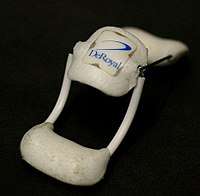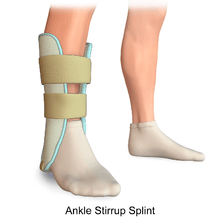Splint (medicine)
A splint is a device used for support or immobilization of a limb or the spine. It can be used in multiple situations, including temporary immobilization of potentially broken bones or damaged joints and support for joints during activity.
Description
A "splint" in considered Non-circumferential whereas a "cast" is considered circumferential. A physician must decide the proper treatment, for a particular injury, to promote healing as well as know the benefits and risks. A splint can be used for certain fractures, soft tissue sprains or tendon injuries, or injuries awaiting orthopedic treatment. A splint may be static, not allowing motion, or dynamic, allowing controlled motion.[1]
Uses

- By the emergency medical services or by volunteer first responders, to temporarily immobilize a fractured limb before transportation;
- By allied health professionals such as occupational therapists, physiotherapists and orthotists, to immobilize an articulation (e.g. the knee) that can be freed while not standing (e.g. during sleep);
- By athletic trainers to immobilize an injured bone or joint to facilitate safer transportation of the injured person; or
- By emergency department (ED) physicians to stabilize fractures or sprains until follow-up appointment with an orthopedist.
Commonly used splints

- Ankle Stirrup – Used for the ankles.[2]
- Finger Splints – Used for the fingers. A "mallet" or baseball finger is a rupture of the extensor tendon and sometimes including a fracture. While surgery may be necessary such an injury may heal if placed in a finger splint.[3]
- Nasal splint[4]
- Posterior Lower Leg
- Posterior Full Leg
- Posterior Elbow
- Sugar Tong – Used for the forearm or wrist. They are named "sugar-tong" due to their long, U-shaped characteristics, similar to a type of utensil used to pick up sugar cubes.[5]
- Thumb Spica – Used for the thumb.[6]
- Ulnar Gutter – Used for the forearm to the palm.[7]
- Volar Wrist Splint – Used for the wrist.[8]
- Wrist/arm splint – Used for the wrist or arm.
Origins
Different forms of the splint have been used sparingly throughout history; however, the splint gained great popularity as a medical device during the French and Indian War. Generally consisting of two small wooden planks, the splint was commonly tied around the fracture with rope, cloth, or even rawhide during frontier times in American history. To this day, the splint is commonly used to secure small fractures and breaks. (See, for example, Henry Gassett Davis.)
Hugh Owen Thomas invented several types of splints but it was not until WWI that his nephew, Sir Robert Jones began using the splint on soldiers.[9]
See also
- Spica splint
- SAM Splint
- Traction splint
- Vacuum splint
- Cervical collar
- Extrication splint (KED, Kendrick's extrication device)
- Long spine board
- Orthopedic surgery
- Buddy wrapping
- PASG (Pneumatic Anti-Shock Garment)
References
- ↑ Splints and Casts: Indications and Methods: American Family Physician. 2009 Sep 1 – Retrieved 2017-10-22
- ↑ Stirrup braces – Retrieved 2017-10-22
- ↑ OrthoInfo: Mallet Finger (Baseball Finger) – Retrieved 2017-10-23
- ↑ Summit Medical: Nasal Splints and Stents – Retrieved 2017-10-22
- ↑ Medscape: Sugar-Tong Forearm Splinting – Retrieved 2017-10-22
- ↑ Letmedco: The Thumb Spica Splint and its Uses- Retrieved 2017-10-22
- ↑ Ulnar Gutter Wrist Splint – Retrieved 2017-10-22
- ↑ Medscape: Volar Splinting – Retrieved 2017-10-22
- ↑ Reel evolution of the splint – Retrieved 2017-10-22